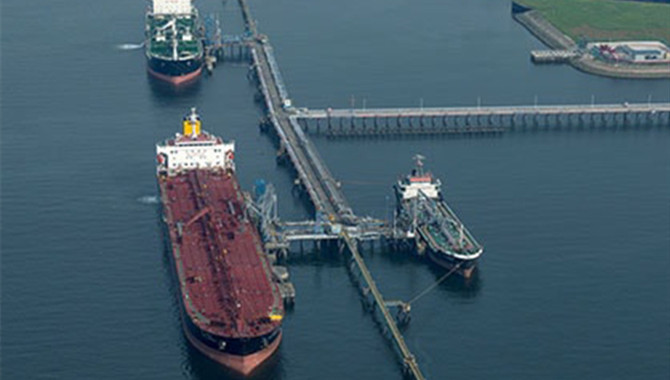
China's biggest refiners Sinopec and PetroChina are increasing their capacity to produce 0.5pc sulphur marine fuel that complies with the International Maritime Organization (IMO) 2020 regulations. But a lack of tax incentives may continue to limit production, despite rising demand.
State-controlled Sinopec yesterday delivered the first bulk supplies of 0.5pc sulphur fuel oil from its 100,000 b/d Qingdao Petrochemical refinery in Shandong province. It sent 5,000t (32,250 bl) by train to nearby Longkou port, where the fuel will be stored in export tanks and supplied to the local bonded bunker market.
The refinery started producing on-specification low-sulphur bunker fuel on 15 November.
Sinopec, which is China's biggest refiner, also started operations at a low-sulphur blending system at its 470,000 b/d Maoming refinery in southern Guangdong province on 29 November, producing on-specification IMO-compliant fuel for the first time. The refinery is now capable of producing up to 5,300 b/d of the bunker fuel and will be able to blend up to 17,700 b/d after an under-construction 2.6mn t/yr residue hydrotreater comes on line by 2020.
Sinopec completed a project to produce 3,500 b/d (200,000 t/yr) of IMO-compliant fuel at its 460,000 b/d Zhenhai refinery in the eastern province of Zhejiang on 28 November. It is aiming to bring it on line later this month. The Zhenhai refinery's capacity to produce IMO-compliant fuels will rise even further after it starts a new 2.6mn t/yr residue hydrotreater. Construction of the unit was finished in early September and it is due to come on line soon.
Sinopec's 320,000 b/d Qilu refinery on 31 October completed the first phase of a blending project capable of producing up to 5,300 b/d of IMO-compliant fuel. It plans to increase the capacity to 17,700 b/d next year. The refinery produced its first 800 bl or so of on-specification low-sulphur fuel oil (LSFO) on 28 November.
The expansions have pushed Sinopec closer to its target to supply 177,000 b/d (10mn t/yr) of IMO-compliant fuel from its 10 coastal refineries next year. Seven of these refineries — the 336,000 b/d Shanghai, 184,000 b/d Hainan and 380,000 b/d Jinling plants, as well as Zhenhai, Maoming, Qilu and Qingdao Petrochemical — can already supply low-sulphur bunker fuel. The other three — Tianjin, Zhanjiang Dongxing and the new Zhanjiang complex — are expected to be ready next year.
State-controlled PetroChina is also pushing ahead with capacity expansions. Its 180,000 b/d Liaoyang refinery in northeast Liaoning province has shipped the first cargo of nearly 21,000 bl (3,200t) of IMO-compliant supplies from Yingkou port to Zhoushan port in east Zhejiang on 29 November.
PetroChina is also targeting raising output of low-sulphur bunker fuel at its 100,000 b/d Liaohe refinery to 17,700 b/d in the fourth quarter of 2020, from just 1,770 b/d now.
The company is planning to supply 71,000 b/d of IMO-compliant fuel from its seven refineries next year. Its 100,000 b/d Wepec joint venture and 410,000 b/d Dalian, 130,000 b/d Jinxi and 200,000 b/d Qinzhou refineries can already produce such fuels, in addition to Liaohe and Liaoyang.
PetroChina's Jinzhou refinery is undergoing an upgrading project that will enable it to process Russian crude and other imports with sulphur content above 0.5pc, as an alternative for decling supply of domestic 0.1pc sulphur Daqing crude. The project including a 1.5mn t/yr residue hydrotreater that is expected to be capable of producing IMO-compliant fuel next year.
PetroChina sells most of its IMO-compliant fuel to state-owned Chimbusco, the largest bunker supplier in China.
But actual output levels from the two refiners will depend on production margins for of IMO-compliant fuel, as well as comparative economics for diesel and gasoline. Rising production of LSFO would reduce feedstock availability for fluid catalytic crackers, which produce the motor fuels.
Production of 10mn t/yr (175,000 b/d) of LSFO would cut gasoline and diesel output by more than 5mn t/yr, with gasoline accounting for two-thirds of the reduction, refinery officials said.
China's tax structure discourages domestic production of low-sulphur bunker fuels. Refineries are eligible for tax rebates on gasoline and diesel exports under both general trading terms and the third-party processing deals. But they only can get tax rebates for fuel oil exported under third-party processing deals, which limits export volumes.
Source:Argus
The opinions expressed herein are the author's and not necessarily those of The Xinde Marine News.
Please Contact Us at:
admin@xindemarine.com


 Ningbo Containerized Freight Index Weekly Commentar
Ningbo Containerized Freight Index Weekly Commentar  Ningbo Containerized Freight Index Weekly Commentar
Ningbo Containerized Freight Index Weekly Commentar  Ningbo Containerized Freight Index Weekly Commentar
Ningbo Containerized Freight Index Weekly Commentar  BIMCO Shipping Number of the Week: Bulker newbuildi
BIMCO Shipping Number of the Week: Bulker newbuildi  Ningbo Containerized Freight Index Weekly Commentar
Ningbo Containerized Freight Index Weekly Commentar  Ningbo Containerized Freight Index Weekly Commentar
Ningbo Containerized Freight Index Weekly Commentar